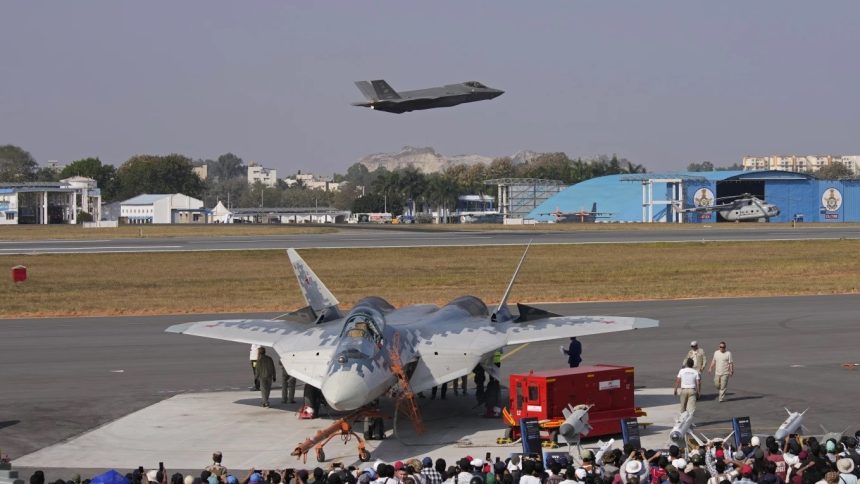In a surprise announcement, U.S. President Donald Trump offered India the opportunity to acquire the F-35 Lightning II. The offer coincided with the jet’s first encounter with the Russian Su-57 at an airshow.
Aero India 2025, the largest air show in Asia, will go down in history as the first time where the Russian Su-57 and the U.S. F-35A shared the scene at an airshow. Both jets performed stunning flying displays over Bengaluru skies, captured in iconic photographs, representing both countries’ fifth generation fighter technologies.
Meanwhile, on the other side of the world, Indian Prime Minister Narendra Modi met U.S. President Donald Trump during a visit to Washington DC. During the encounter, Trump announced an increase in military sales to India and put the F-35 on the table.
“Starting this year, we’ll be increasing military sales to India by many millions of dollars, we’re also paving the way to ultimately provide India with the F-35 stealth fighter,” said Trump during a joint press conference at the White House on Feb. 13, 2025.
It appears that the F-35 proposal might not have been in the works before the meeting, as Indian Foreign Secretary Vikram Misri said shortly thereafter that the F-35 acquisition is only a proposal. “I don’t think with regard to the acquisition of an advanced aviation platform by India, that process has started as yet,” said Misri. “This is currently something that’s at the stage of a proposal.”
It is not clear how India’s strong ties with both the U.S. and Russia will play in the equation and if the relations with the latter will somewhat influence the F-35 deal.
While the U.S. has long offered the F-35 to India, there have been no reports of the Indian Air Force being interested in the jet. Successive Indian governments have also been unwilling to acquire it, given the attendant foreign policy obligations that might impact New Delhi’s diplomacy with Russia.
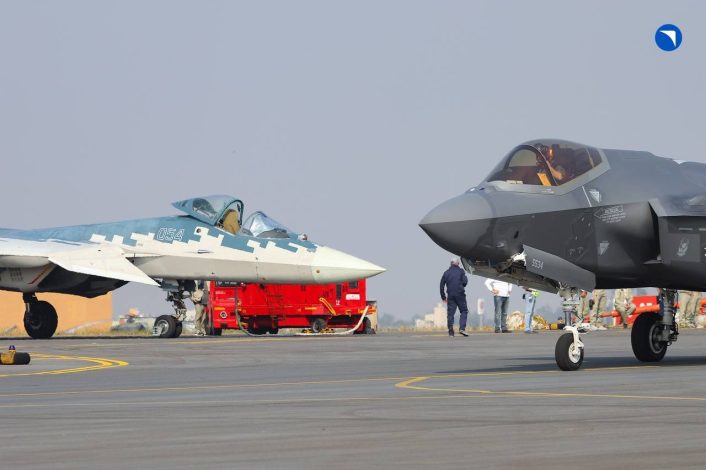
The meeting of the two “rival” fighters
Two F-35s attended the Aero India 2025 air show, while Russia sent one Su-57. One of the F-35s is assigned to Eielson Air Force, Alaska, while the other is assigned to the Vermont Air National Guard, which deployed some of its F-35s to Kadena Air Base, Japan, last month.
Eielson’s F-35 is identified by the serial number 19-5534, which appears to have an interesting origin. In fact, the famous F-16.net website, which hosts a database of the existing F-16s, F-22s and F-35s, reports that this aircraft has the Lockheed Martin construction number AT-15, identifying it as one of the aircraft which was initially being built for Turkey and was later completed for the U.S. Air Force after the order Turkish order was blocked and the aircraft already produced were stored.
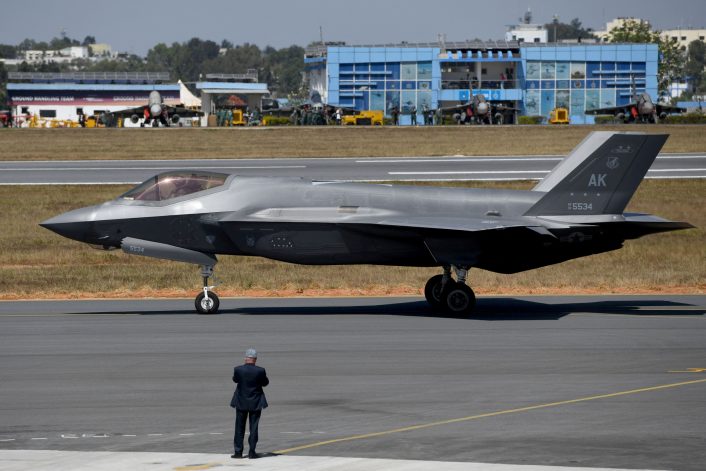
As for the Su-57, the aircraft at Aero India is the number 054, the Felon’s fourth prototype, also known as T-50-4. The same jet, along with the prototype T-50-7, or 057, also visited the Zhuhai Air Show in China in Nov. 2024.
Both the F-35 and Su-57 arrived at Yelahanka air base in India between Feb. 8 and Feb. 9, 2025. Roughly at the same time, the first photos showing the F-35 19-5534 and the T-50-4 emerged online, with the U.S. aircraft taxiing in front of the Russian jet.
🔹#Inde 🇮🇳🔹
Salon Aero India 2025, Su-57 (Russe 🇷🇺) vs F-35 (US 🇺🇸). Il n’y a qu’en Inde qu’on peut les voir aussi proches. pic.twitter.com/08eaGDqnZC
— Bharat Mundi (@BharatMundi) February 12, 2025
Reportedly both the jets were also performing their flight displays within a few minutes from each other, with photos showing them often taxiing at the same time. One particular image that went viral showed the Su-57 on the taxiway, with the F-35 in front of it, earning it the playful description of the American jet being “in the crosshairs” of the Russian fighter.
Aero India 2025 is also the first time that the Su-57 is in India, while it is the F-35’s second visit to India. The first time was in the 2023 iteration of Aero India at Bengaluru.
The rare encounter was also highlighted by the Indian Ministry of Defense in the statement released at the opening of the airshow on Feb. 10: “Aero India 2025 will provide a rare side-by-side comparison of Eastern and Western fifth-generation fighter technology, offering defense analysts, military personnel, and aviation enthusiasts valuable insights into their respective capabilities.”
A little jealous, are we? An F-35A in Su-57’s sights at Aero India 2025. Contrasting stealth designs and colour schemes. pic.twitter.com/FexHVLX2UJ
— Air Power (@RealAirPower1) February 10, 2025
Su-57 in India for the first time
The Su-57 was accompanied by a full team of ground and maintenance crew from UAC (United Aircraft Corporation) and SDB (Sukhoi Design Bureau), the manufacturer and developers of the jet, while the aircraft was piloted by Sukhoi’s chief test pilot Sergey Bogdan. The Russian plane flew over Bengaluru’s skies at least two times, performing jaw dropping aerobatics, including steep climbs, vertical rolls, short radius loops, controlled spins and recoveries.
The UAC and the Russian embassy in India have released videos from inside the cockpit, showing Bogdan at the controls, and from the ground, showing the jet in action. The Su-57 performed short, steep take offs and landings from Yelahanka, similar to what was done in Zhuhai, showing the ability to operate on smaller runways.
Russia meets USA at #AeroIndia2025 🤩
🇷🇺 Su-57E Felon 🤝🏻 🇺🇸 F-35 Lightning II
For the first time ever, two 5th Gen Stealth Rivals are at one airshow!!!
A rare glimpse of next-gen airpower at Asia’s largest Aerospace & Defence Exhibition in #Bengaluru 🇷🇺⚡🇺🇸
AERO INDIA 🇮🇳… pic.twitter.com/IITyFjrqau
— Karnataka Weather (@Bnglrweatherman) February 8, 2025
Russia had long pitched its jet to India. New Delhi was initially a partner in the FGFA (Fifth Generation Fighter Aircraft) program, although it exited the project around 2012. Russia since then has been quietly signalling to India that the doors are still open, and that Moscow is more than willing to offer ToT (Transfer of Technology) and full joint manufacturing.
At the airshow, the Su-57 was also displayed with a wide variety of air-to-air, air-to-ground, anti-ship and anti-radar missiles while on static display.
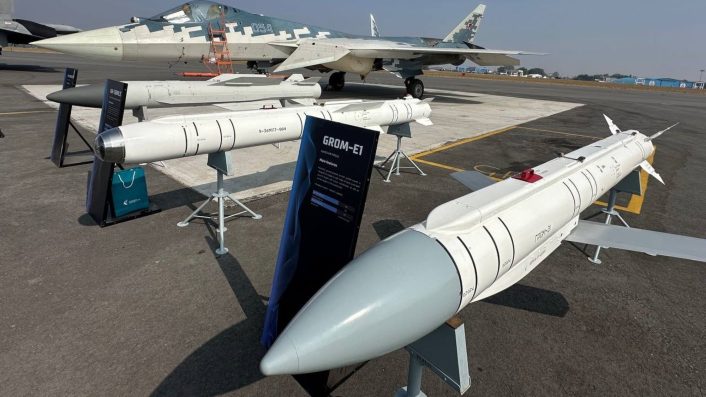
Rosoboronexport and Rostec officials had told this correspondent during the 2019 edition of Aero India that the company is willing to partner with HAL (Hindustan Aeronautics Limited) for producing the plane. HAL already assembles the Su-30MKI from CKD (Completely Knocked Down) kits at the HAL facility in Maharashtra state’s Ozhar, in far-western India.
Russia has now again offered the Su-57 to India, according to statements by a Russian and an Indian official reported by Reuters citing an informal offer. A spokesperson for Russia’s Rosoboronexport mentioned the fighter jet could go into production as early as this year if the Indian government accepts its offer.
🇷🇺 Beauty and mighty — #Su57 at Aero #India 2025! 🇮🇳#RussiaIndia#DruzhbaDosti#AeroIndia2025#AeroIndia pic.twitter.com/Kmkblvj9tT
— Russia in India 🇷🇺 (@RusEmbIndia) February 9, 2025
F-35A and U.S. participation at Aero India
Similarly to the Su-57, the F-35A performed stunning aerobatics, displaying its maneuverability to the crowd. Multiple photos and videos show the F-35 as it flew in the background behind the parked Su-57.
Interestingly, images also showed the Su-57 team closely watching the F-35 as it was taxiing in front of the Su-57 and flew by it during the displays. For both the Russian and U.S. crews this was the first time they got to see each other’s aircraft up close.
Extremely rare sight: F-35 and Su-57 together at Yelahanka Airbase during AeroIndia 2025 pic.twitter.com/GcJ3h2NL0E
— curious side of 𝕏 (@curioXities) February 11, 2025
This nevertheless led to some pretty interesting photographs that showed both the jets near the other at different moments in their flying schedules. As mentioned before, the Indian media and aviation photographers are familiar with the F-35 over Indian skies, as it participated in Aero India 2023, but not the Russian jet.
The American presence at the airshow also included two F-16s, a C-130J Hercules, a C-17 Globemaster III and a B-1B Lancer bomber. The latter, departing from Andersen AFB, Guam, where it is part of the Bomber Task Force 25-1 deployment, conducted two flyovers at Aero India 2025 on Feb. 11 and 13.
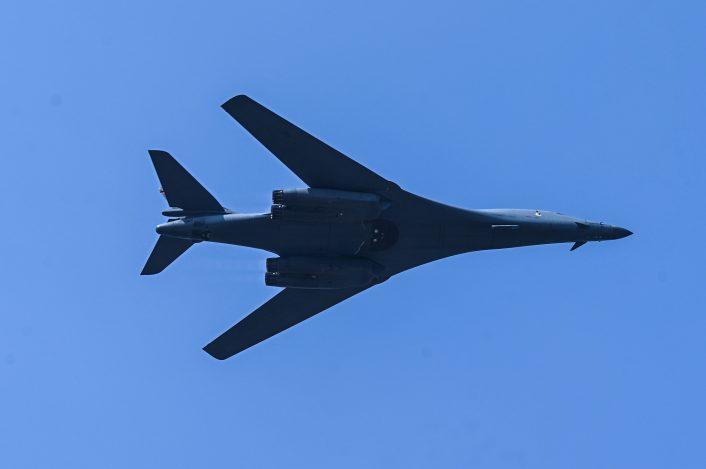
The U.S. Consulate in Chennai previously announced the bomber would undertake a flying display. The B-1B has also visited India before, participating in Aero India 2021 where it flew alongside an LCA Tejas.
Get ready for the roar of the B-1B Lancer—the U.S. supersonic bomber, unmatched in speed and strike power— today at #AeroIndia2025. Keep your eyes glued to the skies around 2:30 p.m. to catch the opportunity of a lifetime.
Where: Aero India, Yelahanka Air Force Base, #Bengaluru… pic.twitter.com/iojNlLiQm5
— U.S. Consulate General Chennai (@USAndChennai) February 13, 2025
Questions over HAL’s reliability
HAL’s reliability has long been in question and its friction with the IAF has been an old subject of debate. However, the long-standing issues boiled over during Aero India 2025 when IAF chief Air Chief Marshal AP Singh expressed displeasure over the delivery of the LCA Tejas Mk.1A variant, according to The Indian Express.
Singh said he has “no confidence” in HAL’s ability to meet the IAF requirements of aligning the Tejas Mk.1A deliveries with the MiG-21 retirement. Saying that the HAL has not been in “mission mode”, he pointed out that the delivered aircraft do not possess the required systems and capabilities.
The Indian Express said IAF has not yet received the first full batch of 40 Tejas aircraft ordered in 2009-2010, with induction starting in 2016. Singh had previously said, “We should go back to 1984 when the project was conceived. The aircraft flew 17 years later in 2001. Then, the induction started another 16 years later in 2016. Today we are in 2024 and I do not have the first 40 aircraft.”
However, other Indian indigenous programs saw some rare developments in terms of the concept models being displayed. For the first time, a full-scale model, rendition and scale model of India’s fifth generation fighter, the AMCA (Advanced Medium Combat Aircraft), was displayed, alongside a scale model of the LCA Mk.2 and a scale model of the TEDBF (Twin-Engine Deck-Based Fighter). All three aircraft are still in their design and development phase, with the first prototypes still being several years away.
Aero India 2025’te F-35 izleyen Ruslar. pic.twitter.com/isD48LEQea
— Tango Down (@Tangocharliejui) February 12, 2025
The Hindu quoted ADA director general Jitendra J. Jadhav and officiating project director of the AMCA programme Rajendra Neeli on the LCA Mk2 and AMCA. While the LCA Mk2 is in a “very advanced stage” with all the “jigs and fixtures completed” and the “airframe on the assembly line,” it would “roll out” by the end of 2025, fly in the first quarter of 2026, and begin induction by the first quarter of 2026. The AMCA meanwhile is projected to take off by late 2028, be certified by 2032, and begin reaching the IAF in 2034.
The most ignored “person” at Aero India 25?
Sad that there was no news or any information given on the LCA Mk.2
No official answered any question!😫😫 pic.twitter.com/mijyDyzvy5
— Vayu Aerospace Review (@ReviewVayu) February 12, 2025
The AMCA will be developed in two phases: a Mk1 with the General Electric F414 98 kN engine and a Mk2 with a 110 kN engine planned to be co-developed with France’s Safran, for which discussions are underway. Safran’s M88 engine powers the Dassault Rafale, which is flown by the IAF, and the naval version Rafale Marine chosen by the Indian Navy to fly off its aircraft carriers.
הודו חשפה דגם בק”מ מלא של מטוס קרב מתקדם בינוני (#AMCA) ב Aero India 2025. המטוס דור 5, כולל שיוט על-קולי (super cruise), מערכות AI ולוחמה מבוססת רשת. זו הסתמכות ההגנה העצמית של הודו תחת ‘Aatmanirbhar Bharat’, כאשר AMCA משלב טכנולוגיה חדישה הדומה ל F-35 ו Su-57. pic.twitter.com/7iCKg9O4bF
— Eli Zusman (@muki46) February 10, 2025
Other developments included the DRDO revealing the Uttam Mk.2 AESA (Active Electronically Scanned Array) radar for the LCA Mk2, which is powered by GaN (Gallium Nitride) technology.

